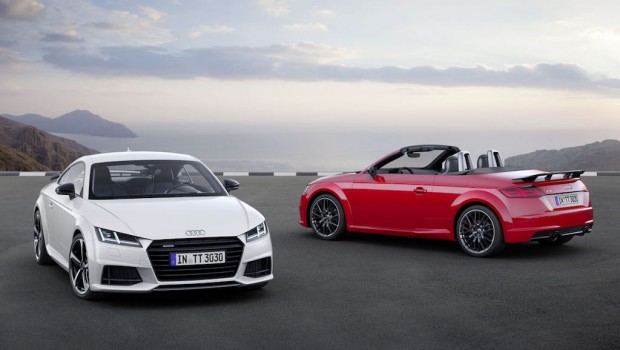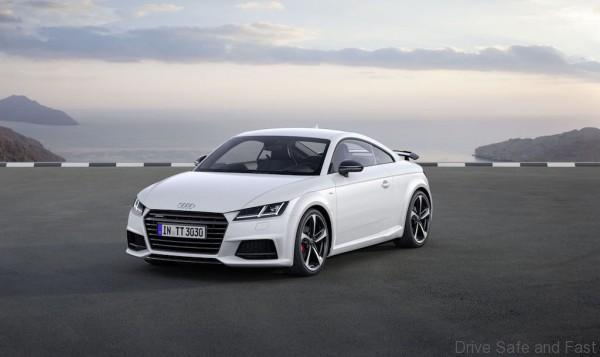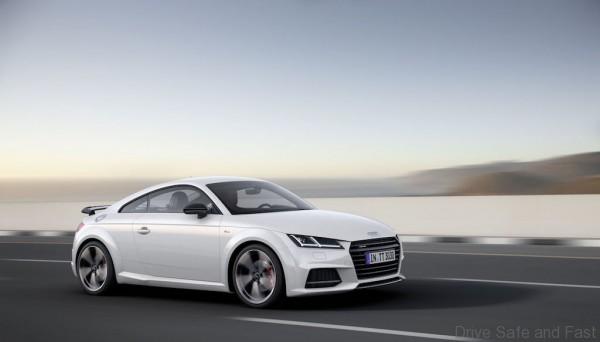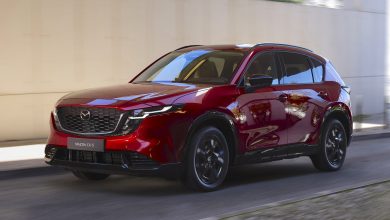டி.டி. எஸ் வரி போட்டி, ஆடி இன்னும் முன்னுக்கு TT ஒரு கூபே மற்றும் TT ரோட்ஸ்டர் என்ற ஸ்போர்ட்ஸ் பாத்திரம் கொண்டு. சரி பின் வலதுசாரி இருந்து விளையாட்டு திரையில் audi மெய்நிகர் காக்பிட் – சிறப்பு மாதிரி வெளிப்புறம் மற்றும் உட்புற விவரங்கள் வேலைநிறுத்தம் ஒரு வரிசை அடங்கும். சிறப்பு பதிப்பு 2016 இறுதியில் இருந்து கிடைக்க வேண்டும்
audi TT எப்போதும் அதன் ஸ்போர்ட்டி வடிவமைப்பு மற்றும் மாறும் கையாளும் வசீகரித்தன அதிகாரத்தைக் கைப்பற்றி இருந்தது. இந்த பாத்திரம் இப்போது எஸ் வரி போட்டி சிறப்பு மாதிரி அடிக்கோடிட்டுக் காட்டப்படுகிறது. Singleframe, முன் கத்தி, வெளிப்புற கண்ணாடி housings மற்றும் விரைவி சேர்க்கைக்கு ஒரு உயர் பளபளப்பான கருப்பு பூச்சு வந்து, அதன் வலிமையான தோற்றம் வலுப்படுத்தும். குறைந்த அளவு பதிப்பு மாதிரி நிலையான பின் வலதுசாரி மேலும் விளையாட்டு முறையீடு கதிர். இந்த கூறு, கூட, உயர் பளபளப்பான கருப்பு வர்ணம் பூசப்பட்ட. வெளியேற்ற அமைப்பின் tailpipe ஒழுங்குபடுத்தும் ஒரு கருப்பு குரோம் பூச்சு வேண்டும்.
நிறுவனம் வசந்த / தடையை அமைப்புகளை கொண்ட விளையாட்டு இடைநீக்கம் அடிப்படை பதிப்பு ஒப்பிடுகையில் பத்து மில்லி மீட்டர் மூலம் TT ஒரு எஸ் வரி போட்டி சவாரி உயரம் குறைக்கிறது. விரும்பிய போதெல்லாம் நிலையான audi இயக்கி தேர்வு அமைப்பு உந்து இயக்கவியல் மேம்படும். இந்த கார், ஆறுதல், மாறும், திறன் மற்றும் தனிப்பட்ட முறைகளில் தங்கள் காரின் பண்புகள் மாற்ற இயக்கியை செயல்படுத்துகிறது.
குறைந்த அளவு பதிப்பு கார் தொழிற்சாலை பொருத்தப்பட்டு அளவு 245/35 டயர்கள் பொருத்தப்பட்ட ஒரு பளபளப்பான கருப்பு ஐந்து-கத்தி வடிவமைப்பு 19 அங்குல சக்கரங்கள், உள்ளது. சக்கரங்கள் பின்னால், சிகப்பு வண்ணம் பூசப்பட்ட பிரே காலிபர்ஸ் சிறப்பம்சங்கள் வழங்கும். உடல் வண்ணங்களை தேர்வு பனிப்பாறை வெள்ளை, நானோ சாம்பல், டேங்கோ சிவப்பு மற்றும் புதிய TT ஒரு வண்ண ஆரா நீல கொண்டுள்ளது. TT ஒரு ரோட்ஸ்டர் எஸ் வரி போட்டி பேட்டை கருப்பு தான்.
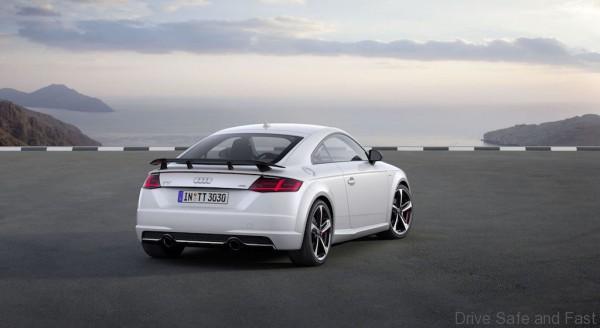
காக்பிட், backrests உள்ள பொறித்தல் எஸ் விளையாட்டாக இடங்களை TT ஒரு எஸ் வரி போட்டி மாறும் தன்மை என்காப்ஸுலேட். அவர்கள் மிகவும் மீள்கட்டமைப்பு பக்க ஆதரிக்கிறது – விருப்பமாக வாயு சமாளிப்பு – ஒரே டிரைவர் மற்றும் பயணிகள் சிறந்த பக்கவாட்டு ஆதரவு வழங்கும். மின்சாரத்தால் அனுசரிப்பு லம்பார் போன்ற நிலையான ஒருங்கிணைக்கப்பட்டது. தட்டையான அடிப்பாகத்தைக் எஸ் வரி மீள்கட்டமைப்பு விளையாட்டு மூன்று-ஸ்போக் வடிவமைப்பு தோல் ஸ்டீயரிங் வழிசெலுத்தல், ஊடகங்கள், தொலைபேசி மற்றும் பேச்சு உரையாடல் அமைப்பு விரைவான மற்றும் எளிதாக அறுவை சிகிச்சை பன்முக பொத்தான்கள் உள்ளன. TT ஒரு வழக்கமான audiயின் மெய்நிகர் காக்பிட் நிலையான என பலகையில் வருகிறது. திசைமாற்றி சக்கரத்தில் ஓட்டுநர் “காட்சி” பொத்தானை மூன்று முறைகள் இடையே தேர்ந்தெடுக்கிறது. அத்துடன் சிறந்த காட்சி மற்றும் “இன்போடெயின்மென்ட்” முறை, குறைந்த அளவு பதிப்பு மாதிரி ஒருங்கிணைந்த வேகம் காட்சி மத்திய சுழற்சி அனைத்து டிஜிட்டல் கருவி கொத்து ஆதிக்கம் செலுத்தும் ஒரு விளையாட்டாக திரை உள்ளது.
நிறங்கள் மற்றும் பொருட்களை வரம்பில் வரையறுக்கும், ஆடி விளையாட்டு முறையீடு மற்றும் நேர்த்தியுடன் ஒரு சீரான கலவை ஏற்படுத்தியுள்ளது: இருக்கைகள் கதவை கைத்தாங்கிகளைப், அல்லது விருப்பமாக அனைத்து நல்லது நப்பா தோல் தோல் மற்றும் Alcantara கலவையை உள்ள மெத்தை உள்ளன – கருப்பு இரு வழக்குகளில். கிரே மாறுபட்ட தையல் இடங்கள், தோல் ஸ்டீயரிங், கதவுகள் மற்றும் கியர் / தேர்வுக்குழு நெம்புகோல் குமிழ் அலங்கரிக்கிறது. உள்பதிக்கும் மத் பிரஷ்டு அலுமினிய, காற்று துவாரங்கள் போது, இருக்கை ஒழுங்குபடுத்தும் சென்டர் கன்சோல் சுற்றி கிளிப் மற்றும் ஒரு ஸ்லேட் சாம்பல் குரோம் பெயின்ட் பூச்சு வேண்டும் உள்ளன.
ஏகலை போலவே, மென்மையான நுரை உடையது அறை மேற்பரப்பில் தொழில்நுட்ப மற்றும் விளையாட்டு இரண்டு குறுக்கே வரும் என்று ஒரு சற்றே உயர்த்தி தேன்கூடு அமைப்பு உள்ளது. தாழ்த்தப்பட்ட பல்கோணங்களின் பல நிலைகளில் மேற்பரப்பில் இருந்து பொருள் ஒரு மில்லிமீட்டர் இரு பத்துகள் ஒரு லேசர் அகற்றுவதன் மூலம் உற்பத்தி செய்யப்படுகின்றன. ஒவ்வொரு தனிப்பட்ட தேன்கூடு சரியாக அறை ஆதரவு வடிவமைப்பு விளிம்புகள் சீரமைக்கப்பட்டது. இதன் விளைவாக, ஒரு தெளிவான மற்றும் நேரியல் முறை ஆகும். கருப்பு குழாய் மூலம் தளம் பாய்களை ஏகலை வரம்பில் இருந்து உள்ளன
audi 230 குதிரைச் 2.0 டிஎஃப்எஸ்ஐ இயந்திரம் மூலம் outfitted சிறப்பு மாதிரி TT ஒரு எஸ் வரி போட்டி வழங்கி வருகிறது. இது ஆறு வேக கைமுறை அல்லது S டிரோனிக் ஒரு முன் சக்கர இயக்கி பதிப்பு கிடைக்கிறது, மற்றும் S டிரோனிக் ஒரு குவாட்ரோ போன்ற. TT ஒரு கூபே எஸ் வரி போட்டி விலை யூரோ 41.940 மணிக்கு தொடங்கும். சிறப்பு மாதிரி ஒரு வகை மோட்டார் வண்டி பதிப்பு யூரோ 44.340 மேல்நோக்கி செலவாகிறது.
Post Views: 1,942
